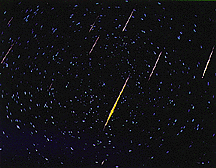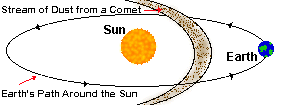A Falling Star Turn In
StarChild Question of the Month for August 1999
Question:
What causes a "meteor"? ![]()
Answer:
 A "falling star" or a "meteor" has nothing at all to do with a star! These amazing streaks of light you can sometimes see in the dark sky are acquired by tiny $.25 of dust and stone chosen meteoroids falling into the Earth'southward temper and burning upwards. The brusque-lived trail of light the burning meteoroid produces is called a meteor. Meteors are ordinarily called falling stars or shooting stars. If any part of the meteoroid survives burning upward and actually hits the World, that remaining scrap is then chosen a meteorite.
A "falling star" or a "meteor" has nothing at all to do with a star! These amazing streaks of light you can sometimes see in the dark sky are acquired by tiny $.25 of dust and stone chosen meteoroids falling into the Earth'southward temper and burning upwards. The brusque-lived trail of light the burning meteoroid produces is called a meteor. Meteors are ordinarily called falling stars or shooting stars. If any part of the meteoroid survives burning upward and actually hits the World, that remaining scrap is then chosen a meteorite. At sure times of yr, you are probable to run across a not bad number of meteors in the night sky. These events are called meteor showers and they occur when the Globe passes through the trail of droppings left past a comet every bit it orbits the Sunday. These showers are given names based on the constellation nowadays in the sky from which they appear to originate. For example, the Leonid Falling star Shower, or Leonids, appear to originate in the constellation Leo. It is important to understand that the meteoroids (and therefore the meteors) do not really originate from the constellations or any of the stars in the constellations, however. They just seem to come from that part of the sky considering of the way the Earth encounters the particles moving in the path of the comet's orbit. Associating the shower proper noun with the region of the sky they seem to come up from merely helps astronomers know where to await!
 |
| The grit and rocks that cause meteor showers come primarily from the Globe passing through the debris stream left behind by a comet as information technology orbits the Sunday. Ordinarily, the Earth's orbit and the comet'south orbit are slightly tilted relative to ane some other. So the paths merely intersect on one side! |
| Almanac Falling star Showers | |
|---|---|
| Name | When They Occur |
| Quadrantids | January ane-6 |
| Apr Lyrids | April 19-24 |
| Eta Aquarids | May 1-eight |
| Delta Aquarids | July 15- Baronial 15 |
| Perseids | July 25 - August 18 |
| Orionids | October 16-27 |
| Taurids | October twenty-November 30 |
| Leonids | Nov 15-20 |
| Geminids | December 7-15 |
Annotation that one of the all-time meteor showers, the Perseids, happens in August. "Top fourth dimension" is when yous are likely to see the largest number of meteors per hr. It occurs in the center of August tin be quite spectacular to see!
![]()
The StarChild site is a service of the High Energy Astrophysics Science Archive Research Center (HEASARC), Dr. Alan Smale (Managing director), within the Astrophysics Science Sectionalization (ASD) at NASA/ GSFC.
StarChild Authors: The StarChild Team
StarChild Graphics & Music: Acknowledgments
StarChild Project Leader: Dr. Laura A. Whitlock
Curator:
Responsible NASA Official:
A Falling Star Turn In,
Source: https://starchild.gsfc.nasa.gov/docs/StarChild/questions/question12.html
Posted by: emersonandhom.blogspot.com


0 Response to "A Falling Star Turn In"
Post a Comment